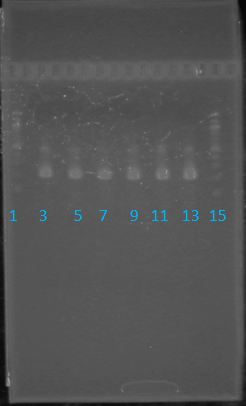Team:Lethbridge Canada/Notebook
From 2012hs.igem.org

| Home | The Team | The Project | Results | Human Practices | Notebook | Safety |
|---|
NotebookMarchBrainstormingProject ideas:
Kill Switches (engineering bacteria to undergo induced or programmed cell death in order to control the organism) The chosen projectAfter dividing in to a few groups based on which project was preferred, each group made a presentation on the proposed project. In the end, we decided to go with the glucose sensing project. Project outlinePossible things to consider Glucose and insulin Immune response Kill switch Delivery system AprilWe divided the team into sub-groups. Each group assumed responsibility for a different aspect of the project. Sub-groups: -Wiki and Mascot Design -Biosafety -Human Practices Wiki and Mascot Design: This group is responsible to obtaining and uploading all necessary information to the wiki. This includes team pictures and biographies, experiments and results, and the projects of the other sub-groups. This will be a priority over mascot design. Biosafety: This group must demontrate the safety protocols that the Lethbridge team practices in the lab. Human Practices: This group is responsible for letting the poublic know what our team is and what we are doing. This can be done creatively. The point it to raise awareness for iGEM, synthetic biology and diabetes. MayMay 8, 2012: Tansformation of Parts from Kit Plate -B0034 in pSB1A2 -K093005 in pSB1A2 -J23100 in J61002 (Amp) -E1010 in pSB2K3 Overnight cultures were also made of: -pMA-T K33109 (HST-1) -pSB1AK3 B0014
Master mix was prepared by mixing the ingredients together in order, as shown above. 20µL worth of master mix was combined with 5µL of plasmid DNA (1-5).
pSB1AK3 BBa_B0014 Incubated at 37˚C for 30mins then stored at -20˚C.
-E1010 pSB2K3 -J23100 J61002 (Amp) -K93005 pSB1A2 -B0034 pSB1A2
Master mix was prepared by mixing the ingredients together in order, as shown above. 20µL worth of master mix was combined with 5µL of plasmid DNA (1-7). -J23100 (J61002) -J23100 (J61002) -B0034 (pSB1A3) -B0034 (pSB1A3) -E1010 (pSB2K3) -E1010 (pSB2k3) -K093008 (pSB1A2) Incubated at 37˚C for 30min then stored in -20˚C.
PCR Parameters: Initial denaturation 95˚C 3mins 30 cycles of: -denaturation 95˚C 30s -annealing (various) 30s -elongation 72˚C 1min
1.5% agarose gel Ran at 120v for 1 hr
1) prefix –J23100-mlc-spe cut site (Red tubes) (sample 3 from May 22nd PCR) 2) Prefix-(fusion)-E1010-suffix (Black tubes) (sample 1 from May 23rd PCR) Contents: -2x Rapid Ligation Buffer 5µL -pGEM-Tor pGem-T Easy Vector 1µL -PCR Product 3 µL -T4 DNA Ligase 1µL -Miliq H2O 1 µL -Ligate at room temp for 1h 15 mins
For each ligation mix: -Added 2µL of ligation mix ( E1010 pcr + pGEM; J23100- mlc + pGEM) to 20.0µL of DH5α) -Incubated on ice for 30mins - 45secs in water bath @ 42˚C - immediately incubated on ice for 5mins -Added 400µL of SOC media; resuspended -Put in shaker for 1hr @ 37 ˚C -200µL cultured onto plate(4 plates, Amp) -Incubate @ 37 ˚C for approximately 16hrs
Sample 3 from PCR product ligation For each ligation mix: -Added 2µL of ligation mix ( E1010 pcr + pGEM; J23100- mlc + pGEM) to 20.0µL of DH5α -Incubated on ice for 30mins - 45secs in water bath @ 42˚C - immediately incubated on ice for 5mins -Added 400µL of SOC media; resuspended -Put in shaker for 1hr @ 37 ˚C -200µL cultured onto plate(4 plates, Amp) -Incubate @ 37 ˚C for approximately 16hrs
-Put 1.5mL of transformed cells in a microcentrifuge tube; centrifuge and repeat until cells from entire tube are in the microcentrifuge tube. -Resuspend pelleted bacterial cells in 250uL Buffer P1 -Add 250uL Buffer P2, mix by inversion -Add 350uL Buffer N3, mix by inversion -Centrifuge for 10 mins @ 13000 rpm -Put supernatant into the QIAprep spin column -Centrifuge for 60s at 14000 rpm, discard flow through -Add 750uL buffer PE and centrifuge for 60s at 14000 rpm -Centrifuge again to get rid of remaining buffer -Add 50uL of Buffer EB to spin columns, let stand for I min, centrifuge for 1 min at 14000 rpm
May 29, 2012: Transformation of E1010 fusion in pGEM in DH5ɑ For each ligation mix: -Added 2µL of ligation mix ( E1010 pcr + pGEM; J23100- mlc + pGEM) to 20.0µL of DH5α -Incubated on ice for 30mins - 45secs in water bath @ 42˚C - immediately incubated on ice for 5mins -Added 400µL of SOC media; resuspended -Put in shaker for 1hr @ 37 ˚C -200µL cultured onto plate(4 plates, Amp) -Incubate @ 37 ˚C for approximately 16hrs
June
|
 "
"






